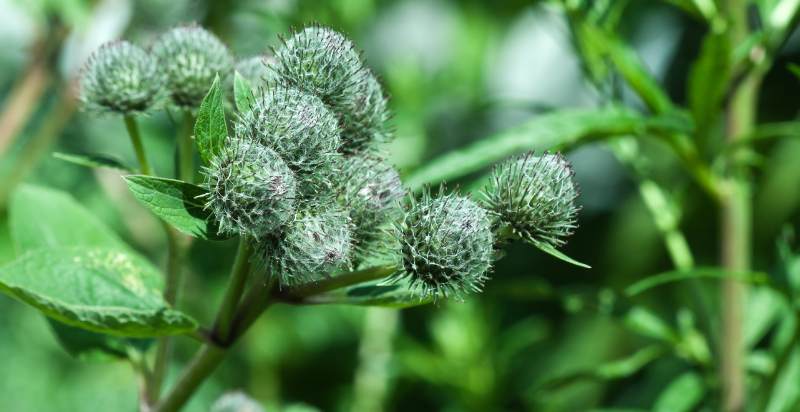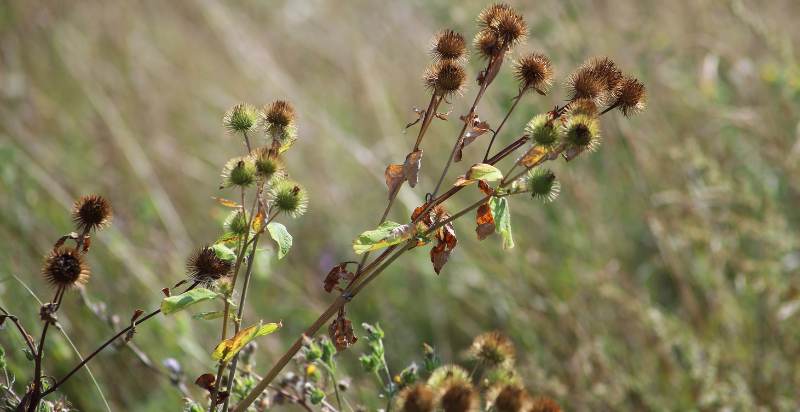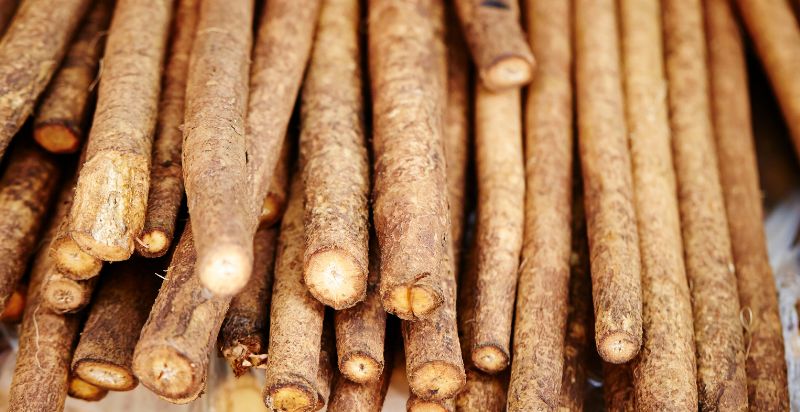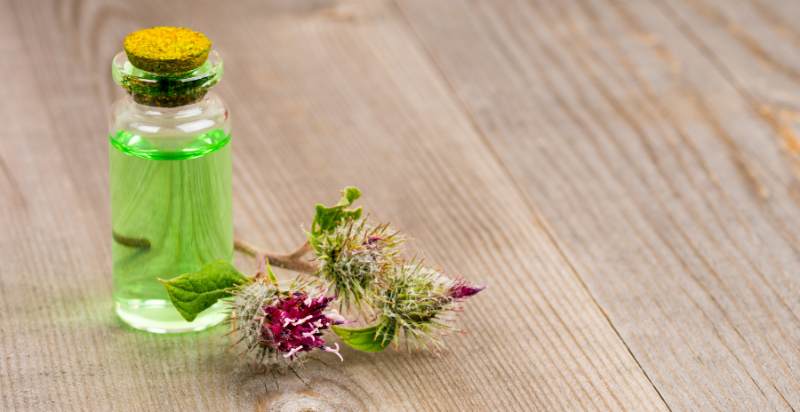Burdock is a plant native to Europe and Asia that has been used for centuries as an herbal remedy and traditional medicine. It is believed to have many health benefits, including helping digestion, reducing inflammation, aiding in weight loss, and fighting bacteria. The root of the burdock plant is most commonly used medicinally and can be found in supplement form, tea, tincture, and topical creams. Here is everything you wanted to know about Burdock.
What is Burdock?
Burdock is a biennial thistle found throughout much of Europe and Asia. The plant’s root is used medicinally, while its leaves and stems are edible when cooked. Burdock belongs to the family Asteraceae, which also includes sunflowers, daisies, chrysanthemums, dandelions, thistles, and lettuces. It is characterized by its long taproot, which grows deep into the soil and can reach up to two feet in length.
History and Origin of Burdock:
Burdock has been used in traditional medicine for centuries. The ancient Greeks, Romans, and Chinese all used burdock to treat various illnesses. In the 16th century, German herbalist and physician Paracelsus (1493–1541) listed numerous benefits of consuming burdock for healing purposes. Burdock was also believed to have magical properties and was used in spells for protection and good luck.
Types of Burdock:
There are two main types of burdock: great burdock (Arctium lappa) and lesser burdock (Arctium minus). Great burdock is native to Europe, northern Africa, and most of Asia. It grows as tall as five feet and has large purple-tinged leaves. Lesser burdock is native to North America and grows about two feet tall. It has smaller leaves that are green in colour.
Uses & Benefits of Burdock:
Burdock root is rich in antioxidants and other compounds that have been used medicinally for centuries. It has traditionally been used to treat skin conditions such as eczema, psoriasis, and acne. It is believed to have anti-inflammatory and antibacterial properties, which may help reduce swelling and fight off infections. It may also aid digestion by acting as a mild laxative or diuretic, helping the body rid itself of toxins.
Burdock root is also commonly used to promote weight loss due to its high fiber content and ability to improve digestion. Additionally, it has been used to treat urinary tract infections, liver problems, colds, headaches, fever, and more.
Burdock has also been used topically for its anti-inflammatory, antibacterial, and healing properties. It is often included in natural skin care products because it can soothe dry skin and reduce inflammation.
How to Plant Burdock?
Burdock is a hardy, easy-to-grow root vegetable. Native to Europe and Russia, it can be grown in most climates with some adaptations. It has been used for centuries as an edible food source and medicinal herb. Burdock is high in vitamins, minerals, dietary fiber, and antioxidants, making it a beneficial addition to any diet.
Planting Burdock:
Burdock prefers well-drained soil that is slightly acidic and rich in organic matter. It can be planted from seed or purchased at garden centres or online retailers. Before planting, work plenty of compost into the soil and till it deeply for best results. To plant seeds directly, sow them 1/4 inch deep, spaced 2 inches apart in rows 1-2 feet apart. When planting starts, space them 8-12 inches apart in rows 2-3 feet apart.
Watering and Care:
Burdock needs regular watering throughout the growing season, particularly during drought or when soil is dry. Keep the bed weed free by hoeing or pulling weeds as necessary. Mulch can also help conserve moisture and suppress weeds. If problems such as aphids, mites, mildew, or other pests occur, treat them with non-chemical methods such as insecticidal soap or natural predators like ladybugs whenever possible.
Harvesting Burdock:
Burdock roots are usually ready to be harvested after 90 days of growth. To harvest, use a garden fork to loosen the soil around the root and pull it out of the ground. If harvesting for food, scrub and peel off any dirt before cutting it into small pieces for cooking.
You can have delicious fresh burdock in your garden with just a bit of work! So get started today and enjoy the bounty that this ancient root vegetable has to offer.
How to Care for and Grow Burdock Roots?
Burdock is a hardy perennial vegetable, easy to grow in most climates. It needs well-drained soil that is slightly acidic and rich in organic matter. Burdock also needs plenty of water to thrive, so keep the soil moist during dry periods. Mulch can help conserve moisture around the plant and suppress weeds.
For burdock root to reach its full potential, you need to give it plenty of room to grow. Leave at least 8-12 inches between each start when planting or 1-2 feet apart when sowing directly from seed. As with any root vegetable, harvest time will vary depending on your climate and soil conditions, but it usually takes 90 days after planting before they are ready to be harvested.
Burdock root can also be grown in containers; ensure the container is large enough and has good drainage. Burdock only needs a little fertilizing. Still, it may benefit from small amounts of organic fertilizer like compost or manure applied every four weeks during the growing season for the best results. Regular harvesting will help keep your plants healthy and productive throughout the season.
With proper care, you’ll soon have fresh burdock roots ready to enjoy! Whether you cook them, use them as an ingredient in herbal medicine, or admire their beauty, this ancient vegetable has something special to offer to everyone who grows it.

Preventions from Pests and Diseases:
Pests and diseases can be a problem when growing burdock roots. Monitor your plants closely for signs of aphids, mites, mildew, or other pests, and take action if any become apparent. Insecticidal soap is an effective non-chemical way to deal with the issue, as are natural predators such as ladybugs.
Rotting can also occur in wet or poorly drained soil conditions, so make sure your beds are well drained and that you stay under water. If possible, mulch heavily around the base of the plant to help reduce the chances of disease. Regular monitoring throughout the season will also help ensure your plants remain healthy and productive until harvest time arrives!
Despite potential issues with pests and diseases, burdock is an easy-to-grow root vegetable that can provide you with delicious and nutritious food. With a little attention, this ancient vegetable can thrive in your garden for many seasons.

How to Harvest Burdock Root?
Burdock roots are usually ready to be harvested after 90 days of growth. To harvest, use a garden fork to loosen the soil around the root and pull it out of the ground. If harvesting for food, scrub and peel off any dirt before cutting it into small pieces for cooking.
Be sure to leave some of the roots in place so they can continue to produce year after year! You can have delicious fresh burdock in your garden with just a bit of work.

How to Store Burdock Root?
Once you’ve harvested your burdock roots, it’s time to store them for later use. The best way to store them is by drying them in a cool, dry place such as a basement or pantry. Place the roots on a wire rack or tray lined with paper towels and allow them to air dry for several days.
Once dried, transfer the burdock root pieces to an airtight container or plastic bag. Store in a cool, dark place away from direct sunlight and moisture for up to six months. You can also freeze the dried pieces for longer storage times!
Whether you eat it fresh, preserve it or admire its beauty, this hardy root vegetable has something special to offer to everyone who grows it. With its long taproots and medicinal properties, it’s easy to see why this ancient vegetable has been around for centuries. Burdock root is a great addition to any garden, offering delicious and nutritious food and ornamental beauty.
How to Use Burdock Root?
Burdock root can be cooked and eaten in many different ways. It has a slightly sweet and nutty flavor, similar to potatoes. Burdock root can be roasted, boiled, or steamed like other vegetables and is often used in soups and stews. The roots may also be pickled, prepared as tempura, or added raw to salads for extra crunch.
In addition to its culinary uses, burdock root is widely valued for its medicinal properties. It has antioxidant, anti-inflammatory, and antimicrobial benefits, making it an ideal choice for those looking for a natural remedy against various ailments.
Whether you use it in the kitchen or admire its beauty, this hearty root vegetable will surely add something special to your garden. The old saying goes, “A burdock in hand is worth two in the bush!”

Potential Risks from Burdock Root:
Although burdock root is a nutritious and versatile vegetable, it can also contain toxins that cause adverse effects in some people. Burdock root contains high levels of oxalates, which are naturally occurring compounds found in many plants. Oxalates can lead to kidney stones and other health complications when consumed in large amounts.
It is important to note that most people do not experience any negative side effects from consuming burdock root in moderate amounts. However, pregnant women should avoid eating burdock root due to its potential inducing labour or miscarriage. If you have any medical conditions or take medications, consult your doctor before adding this plant to your diet.
In Conclusion:
Burdock root is an easy-to-grow vegetable with many benefits. With its delicious taste and medicinal properties, it’s no wonder that this ancient root has been used for centuries! Be sure to harvest this versatile veggie in moderation and enjoy all its potential health benefits. Happy harvesting!
Good luck! 🙂
- Everything You Wanted to Know About Red Tamarillos - June 2, 2025
- A Guide to Tulips: Everything You Need to Know & More… - June 2, 2025
- Guanabana: Description, Flavor, Benefits, And Uses - May 27, 2025

1 thought on “What is Burdock? How to Plant, Grow, and Harvest Burdock Root. ”
Comments are closed.